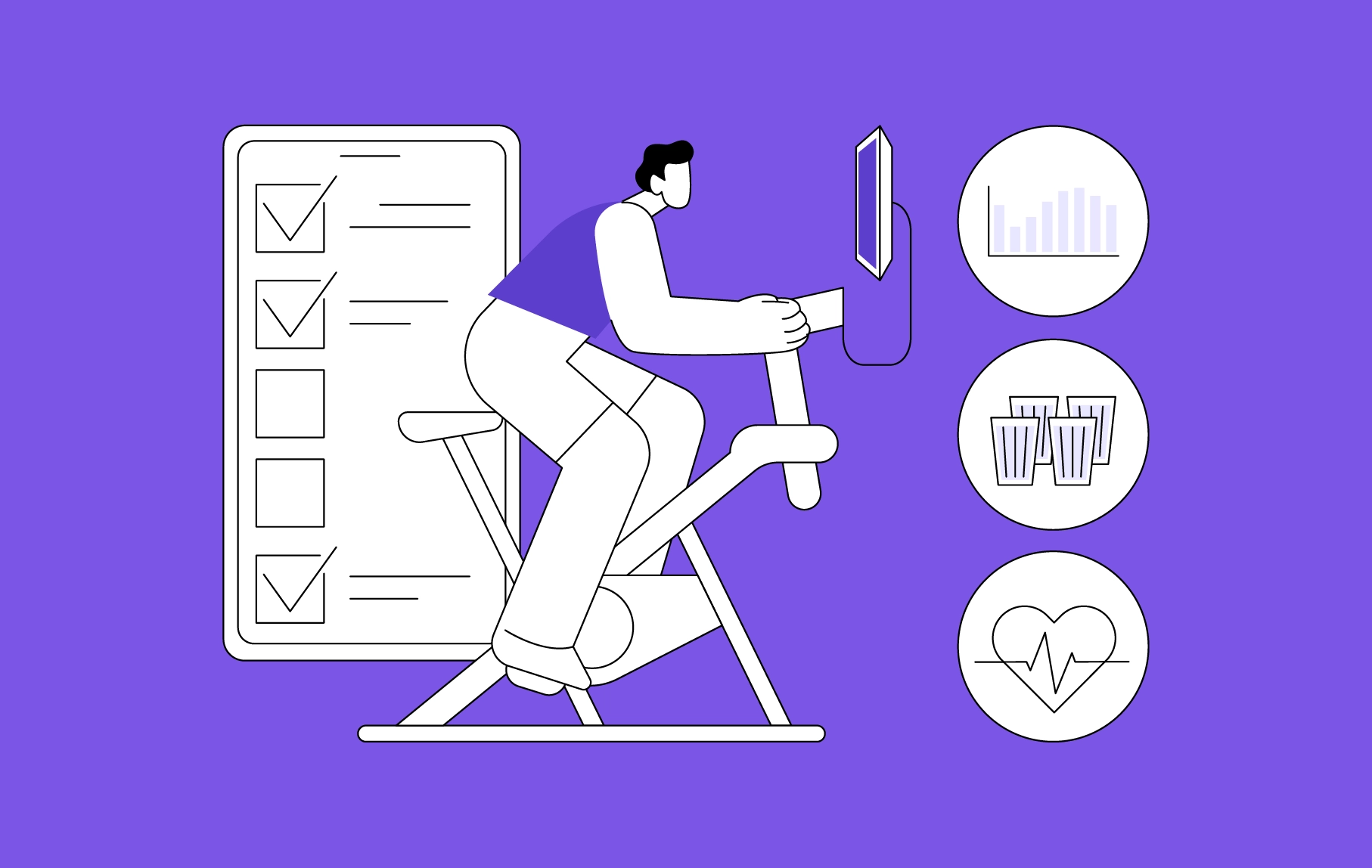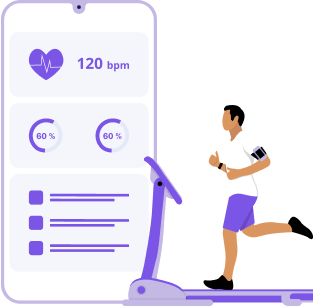- Rising Prevalence of the Fitness Apps: Types and Trends
- Fitness Apps Types
- Fitness Apps Trends
- A Comprehensive List of Fitness App Features
- Personalized Profiles
- User Registration/Login
- Activity Tracking
- Workout Plans and Guides
- Nutrition Plan and Recipe Database
- Integration with Wearables
- Progress Monitoring and Analytics
- Social Media Sharing
- Alerts and Push Notifications
- Audio/Video Player
- How To Create A Fitness App: Step-by-Step Process
- Conceptualize and Plan
- Determine the App Type
- Choose the Tech Stack
- Designing
- Development
- Testing
- Deployment
- Post-launch Support and Maintenance
- Comprehending Fitness App Development Costs
- Compliances Involved in Fitness App Development
- Health Insurance Portability and Accountability Act (HIPAA)
- Health Information Technology for Economic and Clinical Health (HITECH)
- General Data Protection Regulation (GDPR)
- California Consumer Privacy Act (CCPA)
- Data Security Measures
- Payment Card Industry Data Security Standard (PCI DSS)
- Accessibility Standards
- Advertising and Marketing Regulations
- Medical Device Regulations
- How to Monetize Fitness Apps?
- Build a Secure and Scalable Fitness App with Appinventiv
- FAQs
Fitness apps are everywhere these days – and the numbers are nothing short of astounding. Just take a look: there are over 97,000 health and fitness apps available on smartphones and tablets, catering to everything from intense HIIT workouts to gentle yoga flows. Statista predicts that the fitness app market will achieve a revenue of $8.30 billion by the end of 2025 and shoot up to a whopping $10.06 billion by 2029, growing at a CAGR of 4.91% from 2024 to 2029.
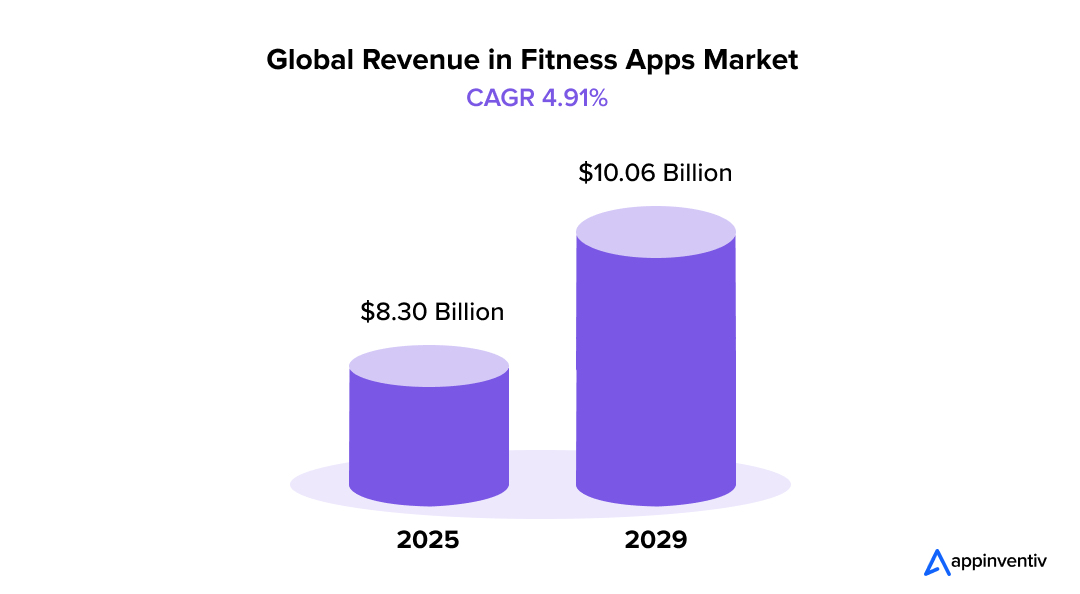
COVID-19 has further accelerated this trend due to users’ increasing awareness of fitness and wellness activities. Now, people are increasingly turning to fitness apps as a convenient way to set goals, track workout routines, monitor fitness levels like BMI, BMR, and water retention, and access personalized training programs. Furthermore, fitness apps enable users to get nutrition information about their daily food intake, such as fiber, carbs, iron, protein, etc.
For instance, MyFitnessPal, one of the first fitness-tracking apps, generated over $310 million in revenue in 2023, a 25% year-on-year increase. With 100 million+ downloads on Google Play Store and App Store, MyFitnessPal is one of the top-grossing fitness apps ever.
Unsurprisingly, diving into fitness application development is a win-win for businesses and users. So, if you are curious about how to create one and what it might cost, you are in the right place. This blog will discuss all the essential aspects of fitness mobile app development, helping you make informed decisions and weaving the right strategies.
You are just a step away from getting your vision into reality.
Rising Prevalence of the Fitness Apps: Types and Trends
Fitness apps have fast become an integral part of our daily routines, transforming how we approach health and exercise. This rapid rise in adoption is not just about keeping up with technology; it is about redefining our wellness experience and boosting your business. So, before we explore the various aspects of fitness and workout app development, we must first understand the numerous trends and types of fitness apps users look for.
Fitness Apps Types
Health and fitness apps typically focus on health monitoring, exercise routines, stress management, diets, and nutrition. Consequently, fitness apps can be developed in various categories. Here is a brief description of each potential fitness app type:

Activity Tracking Apps
Activity tracking apps like Strava and Fitbit monitor physical activity levels, calories burned, distance covered, blood sugar level, and heart rate. They often integrate with wearables like smartwatches to provide real-time data, making it easy to see your progress at a glance.
Workout and Training Apps
Whether you are into HIIT, yoga, strength training, or pilates, workout and training apps like Nike Training Club offer a variety of exercise routines and training programs tailored to different fitness levels and goals.
Nutrition and Diet Apps
Diet and Nutrition planning apps like Lifesum and MyFitnessPal allow users to track their dietary intake, count calories, log meals, and receive personalized nutrition recommendations. They are a great companion to your workout routine, ensuring you fuel your body correctly.
Yoga and Meditation Apps
Yoga and meditation apps like Calm and Headspace offer guided meditation sessions, breathing exercises, and relaxation techniques to promote mental well-being and stress relief.
Personal Trainer Apps
Looking for that extra push? Personal trainer apps like Trainerize and TrueCoach connect users with certified personal trainers who provide virtual coaching sessions, personalized workout plans, and accountability support.
Mood Tracking Apps
Mood-tracking apps like Daylio and Moodpath allow users to monitor and analyze their emotional well-being. Users can track factors influencing their mental health and access resources for managing stress, anxiety, or depression.
FemTech Apps
FemTech apps like Flo Health and Clue address women’s health conditions, offering solutions for reproductive health, menstrual tracking, pregnancy, and menopause management.
Holistic Health and Wellness Apps
Apps like BetterMe and DiabeticU go beyond just physical fitness. They combine workout features with mindfulness tools like meditation, stress management, diabetes control, and even sleep tracking, offering a comprehensive approach to overall well-being.
For instance, Appinventiv developed DiabeticU, a Holistic Health and Wellness Apps that tracks physical activities and helps users monitor their blood glucose levels, log meals, track medications, schedule exercise, and even receive personalized insights through an AI-powered assistant. By integrating these diverse functions, DiabeticU empowers users to take control of their health journey, making it a prime example of how holistic approaches can help manage chronic conditions and improve overall quality of life.
Also Read: How to Develop a Women Health Tracking Application?
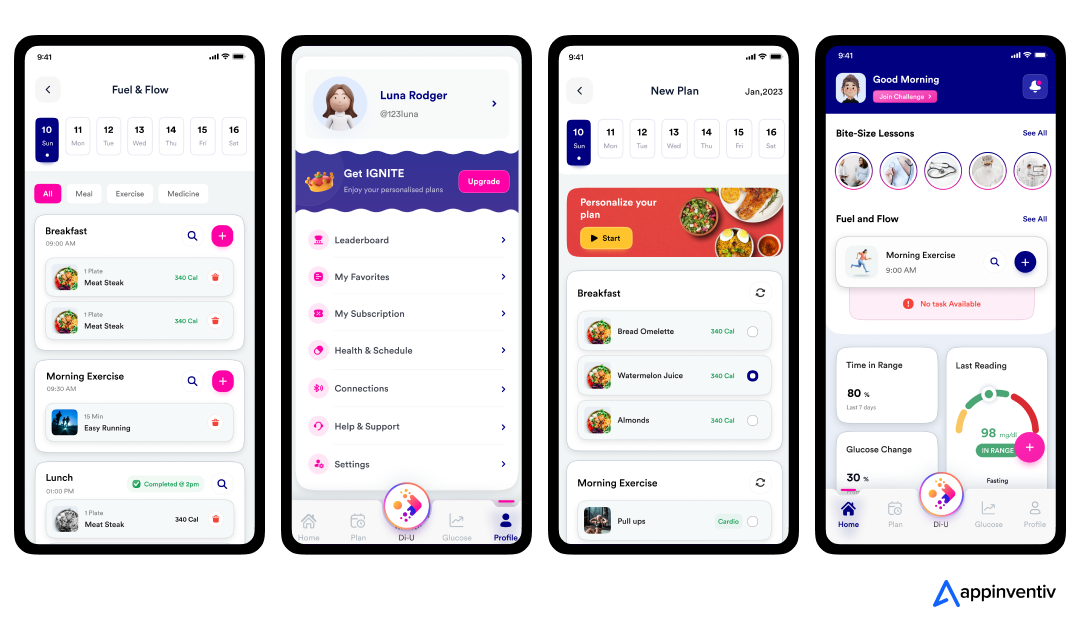
Fitness Apps Trends
The fitness app industry constantly evolves, driven by ongoing technological advancements and changing user expectations. In this section, we explore the key trends shaping the future of fitness applications and what’s next for the digital fitness revolution. Emerging trends in custom fitness application development include:
AI-Driven Personalization
Adopting AI and ML in fitness app creation is one of the most emerging trends. It provides tailored user experiences, workout plans, nutrition advice, and health insights based on individual data, ensuring every user gets a truly personalized experience.
Wearable and IoT Integration
Integration of wearable apps with IoT-connected devices like smartwatches and fitness bands is another vital trend in fitness app development. This trend provides real-time tracking and deeper insights into daily activity, sleep, and overall health.
Immersive Technologies
Virtual and augmented reality is beginning to transform workouts by offering immersive training sessions that mimic real-world scenarios or create virtual fitness classes. This offers immense flexibility and convenience to users.
Community and Gamification
Social features, challenges, and rewards systems are the other lucrative trends in fitness application development. Incorporating such gamification elements increases users’ motivation, engagement, and a sense of community.
Also Read: How AR VR Apps Are Gamifying Exercise And Workout?
Emphasis on Sustainability
Sustainability has become the new norm, especially in modern fitness apps. These platforms now increasingly integrate eco-friendly features, such as tracking carbon footprints and promoting outdoor workouts, to enhance individual health and reduce environmental impact.
Holistic Wellness Focus
Beyond physical fitness, modern apps are integrating mental health tools, such as guided meditation, stress management, and sleep tracking. This holistic approach ensures users receive a comprehensive solution that nurtures their physical and mental well-being, paving the way for a balanced and healthier lifestyle.
Also Read: Mental Health App Development: A Complete Guide
Data Security and Compliance
With increasing scrutiny over user data, fitness apps are emphasizing robust security measures and compliance (details later) with global data protection standards.
A Comprehensive List of Fitness App Features
Depending on their type, health and fitness apps are designed with multiple features, catering to diverse purposes and user needs. Anyone looking to build a healthcare app should ensure it includes a comprehensive list of essential features to meet user expectations.

Personalized Profiles
A fundamental feature of any health and fitness app is the ability for users to create personalized profiles. These profiles allow users to input essential information such as age, weight, height, and fitness goals. Based on individual metrics, apps can provide tailored workout routines, dietary recommendations, and progress tracking, enhancing user motivation and commitment to their fitness goals.
User Registration/Login
This feature enables users to create personal accounts and access the app using their designated credentials or other social accounts like email, Facebook, Instagram, or other platforms.
Activity Tracking
Robust activity tracking is an essential aspect of fitness apps. By seamlessly integrating with wearable devices and smartphone sensors, this feature facilitates monitoring crucial user metrics such as heart points, steps taken, distance traveled, calories burned, and active minutes. Accurate and real-time tracking enables users to monitor their progress and make essential adjustments to stay fit and healthy.

Workout Plans and Guides
Offering users a predesigned set of exercises and the flexibility to create their workout plans is one of the most essential features, catering to different fitness levels, preferences, and user objectives. Additionally, incorporating various media formats, such as 3D animated models, photos, and video illustrations, can further enhance user understanding and illustrate exercises, promoting safety and efficacy.
Nutrition Plan and Recipe Database
A comprehensive health and fitness app should include features for tracking dietary intake and providing nutritional guidance. Users should be able to log their meals, snacks, and hydration levels. Additionally, integration with databases of food items and recipes can further facilitate healthier eating habits and support weight management goals.
Integration with Wearables
Features that enable apps to seamlessly integrate with popular wearables like fitness trackers and smartwatches enhance app functionality. Also, compatibility with third-party apps and services allows users to consolidate health data, promoting a holistic approach to wellness and facilitating data-driven decisions.
Progress Monitoring and Analytics
Enabling users to track their progress and visualize their achievements over time is essential for maintaining motivation and accountability. Health and fitness apps should offer detailed analytics and progress reports, showcasing metrics such as weight loss/gain, body measurements, fitness milestones, and adherence to goals.
(Also read: How Much Does It Cost to Build a Health and Fitness App Like Garmin Connect)
Social Media Sharing
Integrating social media platforms with your app is a critical feature that allows users to share their achievements with family and friends. By sharing their achievements with the global community, users feel motivated and, at the same time, encourage others to embrace a healthier lifestyle. Through their recommendations, businesses can gain new users, create brand awareness, and build credibility.
Alerts and Push Notifications
Incorporating the feature of push notifications enhances user engagement by providing timely updates and reminders for scheduled workouts, progress milestones, or notifications to stay hydrated and maintain consistency in the fitness journey.
Audio/Video Player
An audio and video player integration allows users to access workout playlists, instructional videos, and guided sessions within the app, enhancing the overall user experience. Audio and video features of fitness apps enhance various fitness activities, such as yoga sessions, exercises, running, and meditation.
These are some of the most common fitness app features. Explore our comprehensive blog on the 30 best fitness app features for a deeper dive into these functionalities, categorized by key aspects like admin panel capabilities, user engagement strategies, and customer support mechanisms.
How To Create A Fitness App: Step-by-Step Process
Fitness application development is a multi-step process that involves careful consideration and strategic execution of every stage. By thoroughly understanding each stage of the development process, you can create your fitness app with utmost precision, poised for unprecedented growth and success
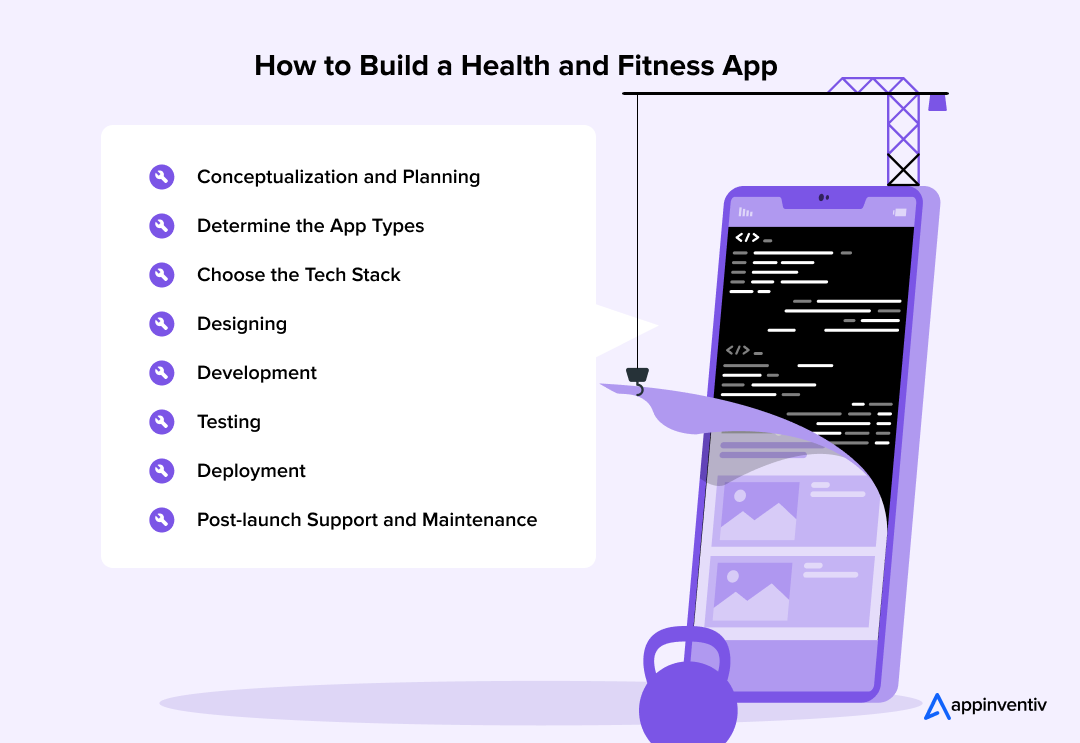
Conceptualize and Plan
The first and foremost step to custom fitness app development starts with conceptualizing the app’s objectives, target audience, and key features. Consider whether your app will focus on specific fitness activities (e.g., workouts, running, yoga) or offer a comprehensive platform with multiple functionalities.
This step involves evaluating market trends, identifying potential gaps in the market, selecting the right category of app you want to build, and planning for essential features.
Determine the App Type
Understand your target audience’s fitness goals, preferences, and pain points to identify the right type of fitness app that will resonate with their needs. Whether it is a workout planner, nutrition tracker, community-based platform, or virtual coach, choosing the right category is crucial for app success.
Choose the Tech Stack
After conceptualization and determining the app type, the next vital step is the integration of the right technologies for developing a robust fitness app. The selection of tech stack significantly affects the custom fitness app development cost and expands or limits the app’s capability.
Designing
Designing a visually appealing UI/UX is crucial for creating an engaging and intuitive app. This stage involves creating visual elements that align with the app’s branding, such as color schemes, typography, and iconography. Iterative design reviews and user testing help refine the design and ensure usability.
Development
This is the actual phase of health and fitness app development, where the development team turns your fitness app idea into a reality. This stage involves building the app’s backend and frontend interface as well as integrating necessary APIs and third-party services. Depending on the selected platform (iOS, Android, or cross-platform), developers use the right programming languages and integrate essential features such as user profiles, activity tracking, workout plans, monetization models, and nutrition logging to promote a healthier lifestyle.
Testing
It is one of the most significant phases before you finally deploy your product to the targeted platform. Testing and quality assurance help identify and fix bugs, glitches, or errors. Testing involves both manual testing by QA engineers and automated testing using testing frameworks to ensure the app’s usability across different devices, screen sizes, and operating systems.
You may like reading: AI in Quality Assurance: The Next Stage of Automation Disruption
Deployment
Once testing is complete and the app meets quality standards, it is ready for deployment. At this stage, the app is submitted to the targeted platforms like the Apple App Store and Google Play Store, following their respective guidelines and requirements.
Post-launch Support and Maintenance
After launching your health and wellness app, continual support and maintenance are crucial to stay competitive. This stage involves monitoring app performance, addressing user feedback, fixing issues, analyzing user data, and releasing regular updates to add new features or improve existing ones.
By following this step-by-step fitness app development process, businesses can create a high-quality wellness app that meets user needs, drives engagement, and achieves business objectives.
Comprehending Fitness App Development Costs
The cost to develop a fitness app varies based on numerous factors such as the app’s complexity, features, UI/UX design, compatible platform, regulatory compliance, location and expertise of the development company, and so on.
On average, a basic fitness app with essential functionalities like workout tracking and nutrition logging for a single platform (iOS or Android) can range from $30,000 to $100,000. For a more complex app with advanced functionalities such as personalized coaching, social features, integration with wearable devices, robust analytics, and customer support, the cost can range between $100,000 to $300,000 or more.
Considering the features and functionalities that align with your app’s objectives and budget constraints is essential. Regular updates and ongoing app maintenance also contribute to overall fitness app development costs.
Expert Advice: You can build a Minimum Viable Product (MVP) to keep fitness app development costs under constraint. MVP will help you deploy your product with limited features, gain user feedback, and obtain funding from investors, helping you launch the final product with advanced functionalities.
You may like reading: How much does it cost to build a fitness app like Hevy?
Compliances Involved in Fitness App Development
When creating your own fitness app, ensuring compliance with various regulations is crucial to protect user data, ensure safety, and maintain legal and ethical integrity. Some critical compliance considerations for fitness mobile app development include:

Health Insurance Portability and Accountability Act (HIPAA)
Compliance with HIPAA is mandatory if your fitness app collects or stores protected health information (PHI), such as user health data or medical history. This includes incorporating robust security measures to protect PHI and adhering to HIPAA’s privacy and confidentiality requirements.
Health Information Technology for Economic and Clinical Health (HITECH)
As part of the American Recovery and Reinvestment Act of 2009, the HITECH Act expands upon HIPAA regulations to address the security and privacy of electronic health information (EHR). Compliance with the HITECH Act is crucial for apps handling electronic PHI to ensure the security and privacy of patient data in the US.
General Data Protection Regulation (GDPR)
Adhering to GDPR is crucial if your app collects or processes data of EU users. To address this regulation, you must obtain explicit consent for data collection, provide users with transparent information about data processing practices, and ensure the security and confidentiality of user data.
California Consumer Privacy Act (CCPA)
Enacted in 2018, the CCPA is a comprehensive privacy law that is essential for companies that collect the personal information of California residents, including healthcare organizations and fitness apps that serve users in California.
Data Security Measures
Integrating stringent security measures to protect user data from unauthorized access, breaches, and cyberattacks is essential. This includes regular security audits, encryption of sensitive data, and compliance with industry standards such as ISO 27001.
Payment Card Industry Data Security Standard (PCI DSS)
If your app stores and processes payment card information, implementing secure payment processing systems and adhering to PCI DSS requirements is essential to protect payment card data and prevent fraud.
Accessibility Standards
Ensuring the app’s accessibility for users with diverse needs is important for inclusive app design. Compliance with accessibility standards like the WCAG (Web Content Accessibility Guidelines) ensures that users with varying needs, including people with disabilities, can access and use the app effectively.
Advertising and Marketing Regulations
Compliance with relevant regulations, such as the Federal Trade Commission (FTC) guidelines and applicable advertising laws, is necessary if your app includes advertising or marketing features. This includes ensuring transparency, accuracy, and fairness in advertising practices.
Medical Device Regulations
If your app includes features that qualify it as a medical device, compliance with regulatory frameworks such as the European Union’s Medical Device Regulation (MDR) or the US Food and Drug Administration (FDA) is essential.
How to Monetize Fitness Apps?
Monetizing a fitness app effectively requires a strategic approach that aligns with user expectations and market trends. By offering valuable features and relevant revenue models, you can generate lucrative ROI. Here is a brief table to help you leverage several monetization strategies for Fitness, Yoga, and Gym App Development.
| Monetization Strategy | Description | Real World Examples |
|---|---|---|
| Freemium Model | This allows users to access the app’s core functionality for free while offering additional value or premium content through subscriptions. | Nike Training Club |
| Subscription | Different tiers of subscription plans grant users access to exclusive content, advanced analytics, or ad-free experiences catering to various user preferences and budgets. | Peloton |
| In-App Purchases | This strategy allows selling digital products, such as workout plans, nutrition guides, fitness challenges, or virtual classes, as in-app purchases. | MyFitnessPal |
| Advertisement Revenue | Display targeted advertisements such as banner ads, interstitial ads, native ads, or rewarded videos within the app and generate revenue through ad impressions or clicks. | MapMyRun |
| Affiliate Marketing | Partner with fitness brands and integrate affiliate links or promotional codes within the app to incentivize users to make purchases through your platform. | MyFitnessPal (for nutrition products) |
| Sponsorships and Partnerships | Collaborates with corporate wellness programs to offer sponsored challenges and promotions to their users. | Fitbit |
By implementing one or more of these monetization strategies, businesses can generate income from their fitness apps while providing value to users and fostering long-term engagement.
Related Article: How Much Money Can You Earn Through An App?
users, caregivers, researchers, and businesses.
Build a Secure and Scalable Fitness App with Appinventiv
With the rapid growth of digital fitness platforms, it is essential to partner with a reputed mobile app development company to ensure your app meets today’s standards and is ready for tomorrow’s challenges. This is where we come in.
We have hands-on experience in providing secure and scalable fitness application development services. With a strong focus on user-centric design, robust security measures, industry regulations, and scalable architecture, we ensure that your fitness app meets and exceeds modern users’ expectations.
With a team of 1600+ tech professionals, we have delivered over 3000 successful projects for various industries, including Soniphi, Health-e-People, and YouComm in the healthcare industry. All our developed solutions can be integrated with wearable devices, offering actionable insights for better wellness.

By leveraging cutting-edge technologies such as AI, machine learning, and data analytics, we empower businesses to embark on their fitness app development journey with confidence and convenience. Furthermore, our commitment to using robust security measures, continuous improvement, and adherence to industry best practices ensures that your fitness app remains secure and competitive, assisting users in achieving their fitness goals effectively.
So, why wait? Contact us now and transform your vision into a dynamic, user-friendly platform that drives engagement, builds trust, and scales effortlessly as your business grows.
FAQs
Q. Why opt for AI-enabled fitness app development?
A. AI-enabled fitness apps like Fitbod leverage machine learning algorithms and other transformative technologies to provide users with personalized experiences, customized workout plans, adaptive coaching, and data-driven insights tailored to individual users’ needs and goals. Here are some of the many benefits of AI-enabled fitness app development:
- AI allows for personalized experiences tailored to individual users’ fitness levels, goals, and preferences, leading to higher user engagement and adherence.
- By leveraging the power of AI and ML, fitness apps offer intelligent features such as automated workout adjustments, predictive analytics for injury prevention, and virtual personal trainers. This empowers users to optimize their fitness journey like never before.
- AI can analyze vast amounts of data, user behavior, and preferences to provide actionable insights, nutrition recommendations, and real-time feedback, helping users achieve their fitness objectives more effectively.
Overall, AI-enabled fitness apps offer a cutting-edge solution to address the evolving needs of users in the health and wellness space.
Q. What are the benefits of fitness app development?
A. Fitness mobile app development offers a myriad of benefits for both users and businesses alike. Some of the most remarkable benefits of fitness app development are:
- Convenience: Fitness apps allow users to exercise anytime, anywhere, leading to increased user engagement and retention.
- Personalization: These apps can tailor workout plans, nutrition recommendations, and coaching based on users’ fitness levels, goals, and preferences, attracting more users and increasing customer lifetime value.
- Accessibility: Fitness apps make exercise accessible to a wider audience, including individuals with busy schedules, limited mobility, or geographical constraints. It helps improve brand awareness and revenue potential.
- Data Tracking and Analysis: These apps allow users to track various health metrics, such as steps taken, calories burned, sleep patterns, and workout intensity, enabling targeted marketing campaigns, product improvements, and strategic decision-making.
- Integration with Wearable Devices: Fitness wearable app development syncs data between the app and wearable devices, enhancing the accuracy and convenience of activity tracking. It can position your brand as a thought leader in the fitness industry, increasing brand loyalty and customer retention.
Q. How to select the right category for fitness app development?
A. Here are some of the proven strategies to choose the right category for fitness app development:
- First, businesses must consider vital factors such as target audience demographics, market trends, user needs, and product objectives.
- Next, they should conduct thorough market research to identify emerging trends, niche markets, and opportunities for innovation.
- Furthermore, they can evaluate the competitive landscape and assess the viability of different categories based on user preferences and demand.
- Ultimately, choose a category that aligns with your target audience’s needs, fits your business goals, and offers potential for growth in the competitive fitness app market.
Q. How much does it cost to develop a fitness app?
A. The cost to build a fitness app ranges between $30,000 to $300,000 or more, depending on your unique project requirements. To gain a more accurate estimate for fitness app development, discuss your project idea with us and get a tailored quotation.
Q. How to build a fitness app?
A. Here is a step-by-step process to build your fitness app:
- Conceptualization and Planning
- Determine the App Types
- Choose the Tech Stack
- Designing
- Development
- Testing
- Deployment
- Post-launch Support and Maintenance
Please refer to the above blog to gain an in-depth understanding of these steps


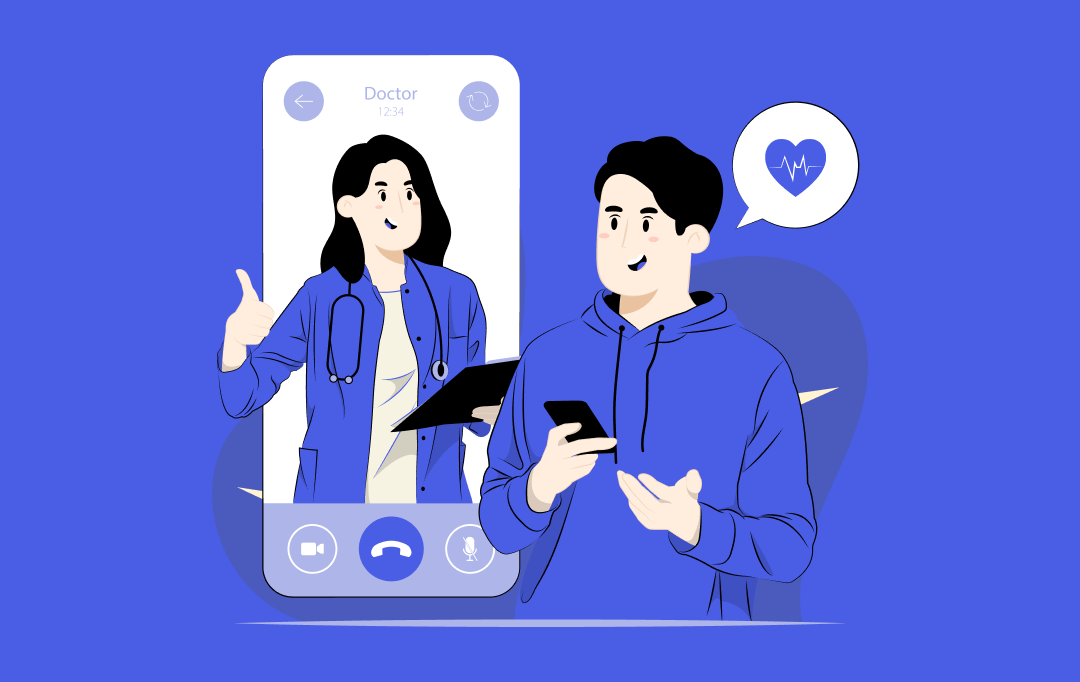
Why Telehealth Security is Non-Negotiable for Patient Trust and How to Achieve It
Key takeaways: Telehealth security is crucial for patient trust and the continued adoption of digital healthcare services. The rising tide of cyber threats, from ransomware to inadequate authentication, poses significant risks to patient data and provider reputation. Implementing robust security measures like end-to-end encryption, multi-factor authentication, and regular audits is non-negotiable. Compliance with regulations like…

10 Ways Healthcare Providers Are Using Patient Analytics to Enhance Care Plans and Optimize Outcomes
Imagine a world where doctors don’t just react to health crises, but predict and prevent them before they happen. This is the reality with patient analytics for healthcare providers. The healthcare industry is no longer limited to treating symptoms—it’s now about understanding patterns, making smarter decisions, and delivering care that’s truly personalized. And it’s not…
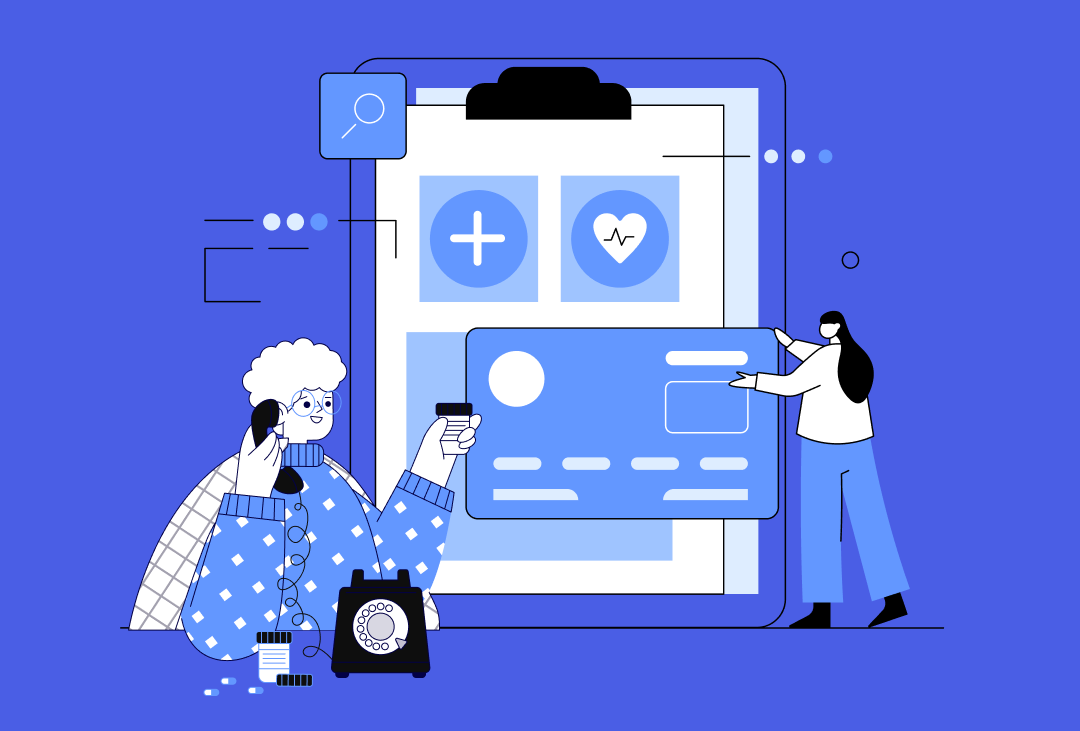
Exploring the Role of Personalization in Healthcare through Technology
Key takeaways: Personalization in healthcare transforms patient care from generic, population-based treatments to individualized approaches tailored to each patient's unique needs. Advanced technologies like AI, IoMT, and genomics are the core enablers for tailoring medical treatments. Personalization drives significant benefits, including improved patient outcomes, higher engagement, and reduced costs. The future of healthcare is hyper-individualized,…






